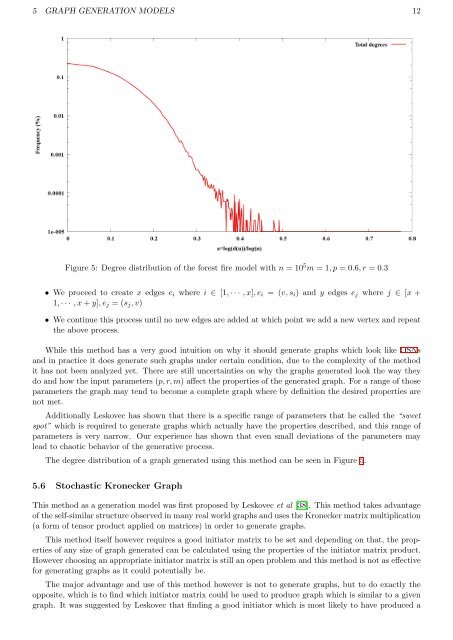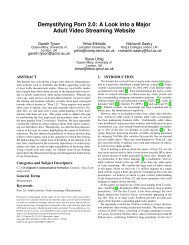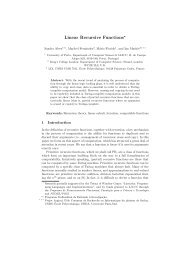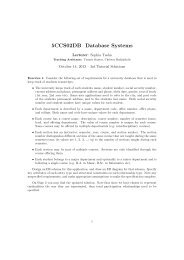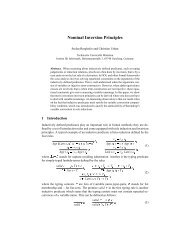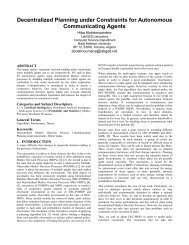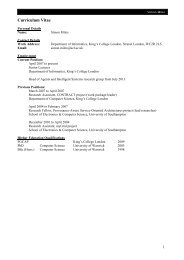Upgrade Report - Department of Informatics - King's College London
Upgrade Report - Department of Informatics - King's College London
Upgrade Report - Department of Informatics - King's College London
- No tags were found...
You also want an ePaper? Increase the reach of your titles
YUMPU automatically turns print PDFs into web optimized ePapers that Google loves.
5 GRAPH GENERATION MODELS 12Figure 5: Degree distribution <strong>of</strong> the forest fire model with n = 10 5 m = 1, p = 0.6, r = 0.3• We proceed to create x edges e i where i ∈ [1, · · · , x], e i = (v, s i ) and y edges e j where j ∈ [x +1, · · · , x + y], e j = (s j , v)• We continue this process until no new edges are added at which point we add a new vertex and repeatthe above process.While this method has a very good intuition on why it should generate graphs which look like OSNsand in practice it does generate such graphs under certain condition, due to the complexity <strong>of</strong> the methodit has not been analyzed yet. There are still uncertainties on why the graphs generated look the way theydo and how the input parameters (p, r, m) affect the properties <strong>of</strong> the generated graph. For a range <strong>of</strong> thoseparameters the graph may tend to become a complete graph where by definition the desired properties arenot met.Additionally Leskovec has shown that there is a specific range <strong>of</strong> parameters that he called the “sweetspot” which is required to generate graphs which actually have the properties described, and this range <strong>of</strong>parameters is very narrow. Our experience has shown that even small deviations <strong>of</strong> the parameters maylead to chaotic behavior <strong>of</strong> the generative process.The degree distribution <strong>of</strong> a graph generated using this method can be seen in Figure 5.5.6 Stochastic Kronecker GraphThis method as a generation model was first proposed by Leskovec et al [38]. This method takes advantage<strong>of</strong> the self-similar structure observed in many real world graphs and uses the Kronecker matrix multiplication(a form <strong>of</strong> tensor product applied on matrices) in order to generate graphs.This method itself however requires a good initiator matrix to be set and depending on that, the properties<strong>of</strong> any size <strong>of</strong> graph generated can be calculated using the properties <strong>of</strong> the initiator matrix product.However choosing an appropriate initiator matrix is still an open problem and this method is not as effectivefor generating graphs as it could potentially be.The major advantage and use <strong>of</strong> this method however is not to generate graphs, but to do exactly theopposite, which is to find which initiator matrix could be used to produce graph which is similar to a givengraph. It was suggested by Leskovec that finding a good initiator which is most likely to have produced a


